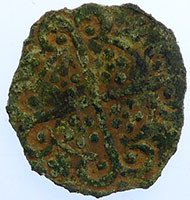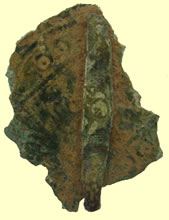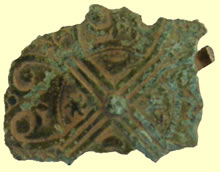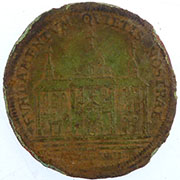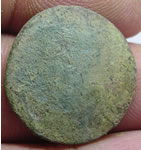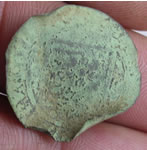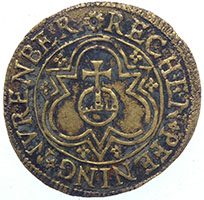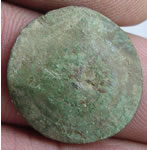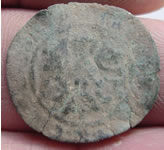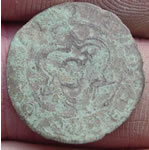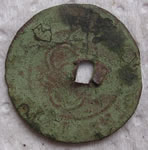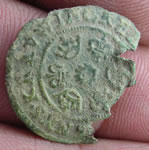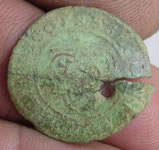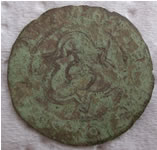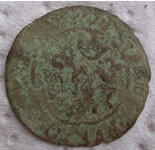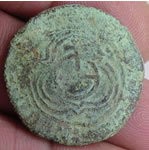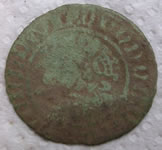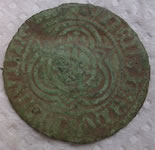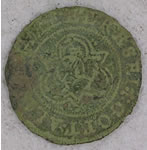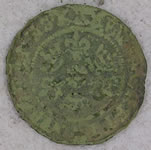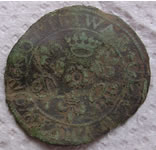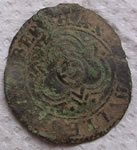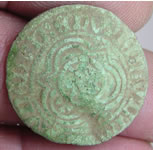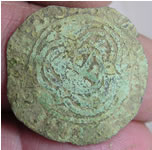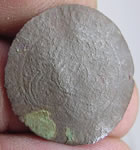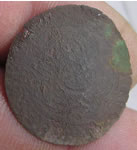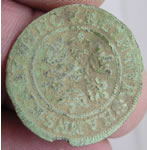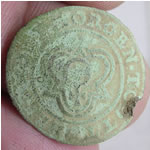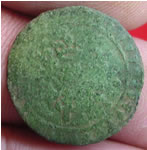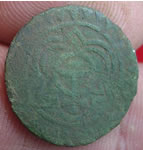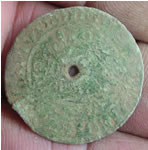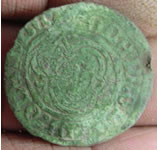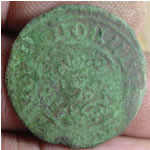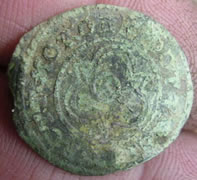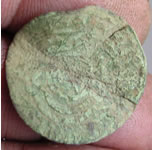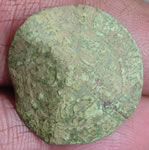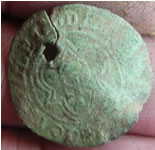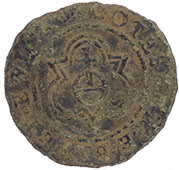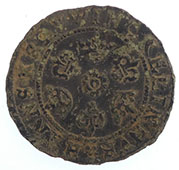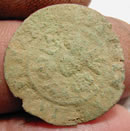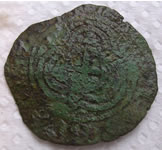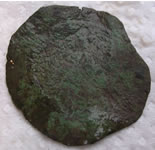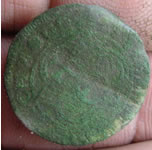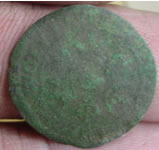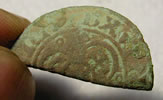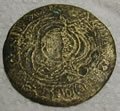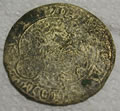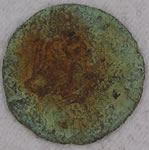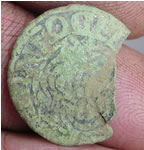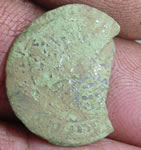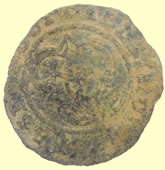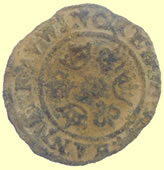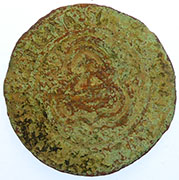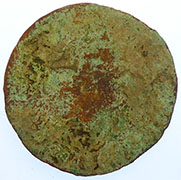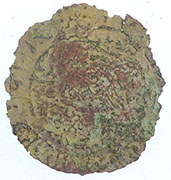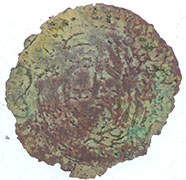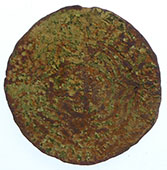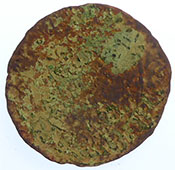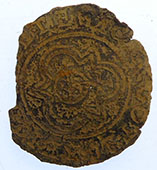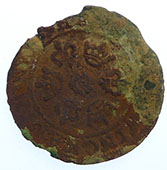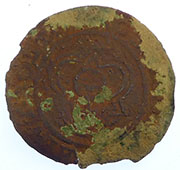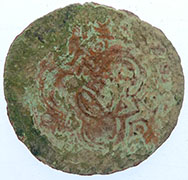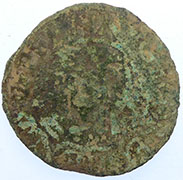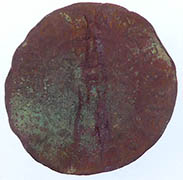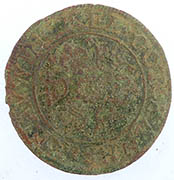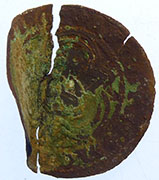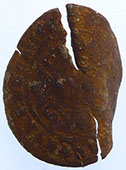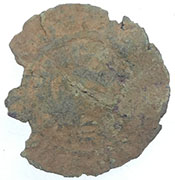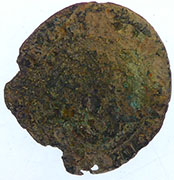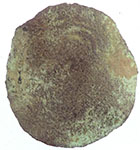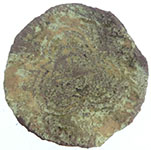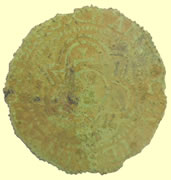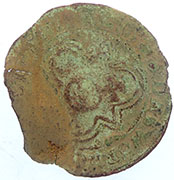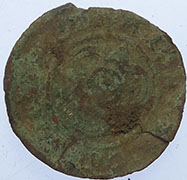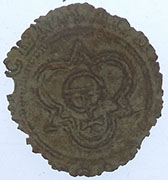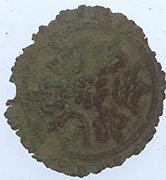

Metal detecting holidays in England with the World's most successful metal detecting club.20 years plus.
Twinned with Midwest Historical Research Society USA.
Jettons
|
||||||||||||||||||||||||||||||||||
|
Jetons: Their Use and History - Great web site detailing how they were used
Ref books used - Michael Mitchiner Jetons Volumes |
||||||||||||||||||||||||||||||||||
English JettonsEnglish jettons were first produced during the reign of Edward 1st. Many were struck from dies made using the same portrait punches as sterling pennies; implying striking by mint officials. Jettons made in England always have a central punch mark on one face, which is thought to relate to centring the disc during flan production (Mernick and Algar in Saunders ed. 2001, 218); sometimes this has developed into a central piercing. Most, though not all, English jettons are anepigraphic, that is, they lack a legend; sometimes examples that carry legends are nonsensical. The major works on English jettons are Berry (1974) and by Mernick and Algar (in Saunders ed. 2001); between them they divide the English series into five main groups based on the module, and a further number of types based on design. An online resource which includes an up-to-date catalogue is curated by Philip Mernick. In the past many English jettons were termed ‘Anglo-Gallic’ (e.g. by Barnard 1916), but this was before their relationship to coins struck at the Tower mint was established; only a few jettons can now legitimately be called Anglo-Gallic. The first group, consisting of the so-called ‘sterling’ and allied issues, represents by far the most common type of English jetton. As noted, these are of similar size to contemporary pennies, but in copper alloy rather than silver, and bear either the same busts (Berry Type 1), or a multitude of other designs (Berry Types 2-20). A second group of English jettons are thought to be contemporary with the earliest of the sterling series, but are larger, at c. 25-27mm in diameter. Their size might relate to the short-lived groat of Edward I (issued 1279-1281). They might have been used as ‘wardrobe counters’ relating to the king’s personal expenditure (Mernick and Algar in Saunders ed. 2001, 222). Examples often feature a long cross on the reverse with stars and crescents in alternating quarters. As with groats of Edward I, these large early English jettons were often converted into jewellery items, by the addition of a riveted clip (Bliss 2017; these needs to be recorded under the appropriate Object Type term); it was normally the cross on the reverse which was displayed. A third group of English jettons are of a later date. Their size, bigger than the broadly penny-sized sterling and allied issues, can be related to the coin denominations issued for Edward III in the 1340s, specifically his halfgroat. The most common reverses in this group are the Standing King and Seated King. A fourth group are generally even larger and are thought to be wardrobe counters of the second half of the 14th century. A final group consists of contemporary copies of jettons (Mernick and Algar in Saunders ed. 2001, 224). |
||||||||||||||||||||||||||||||||||
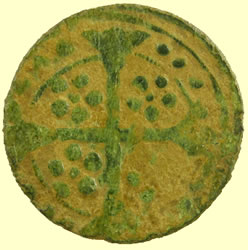 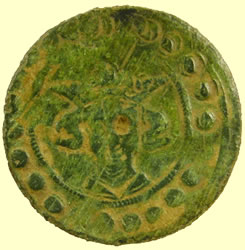 |
||||||||||||||||||||||||||||||||||
1310-14 Sterling bust English Jetton Edward II Class XI Rev - Long cross patonce 6 pellet clusters in angles, border pellets Obv - Bust Class II in circle, border pellets
1310-14 Edward II Sterling bust English Jetton - Class XI Obv Bust (class 11) in circle Rev Three armed cross, in each angle a 'facing bare human head'border a succession of letters 'B'and 'S' Ref Mitchiner 131
1302-07 Edward 1st Class X: Bifoliate crown Jetton Obv Bust (classs 10) accosted by stars :borde, pellets and stars Rev Long cross moline , 5 pellet cluster in each angle:border, star in each segment Ref Mitchiner 96
1310-14 Sterling bust English Jetton Edward II Class XI Rev - Long cross patonce 6 pellet clusters in angles, border pellets Obv - Bust Class II in circle, border pellets |
||||||||||||||||||||||||||||||||||
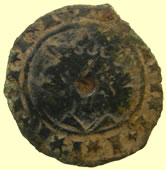  |
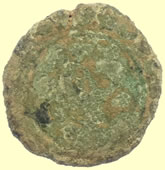 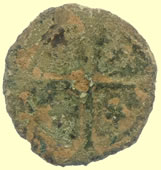 |
|||||||||||||||||||||||||||||||||
Unknown type with *I* I on Obv instead of pellets 1321 Edward II English jetton - Bust type Class XI Obv Edward bust with succession of * and I Rev Long cross with pellets Similar Ref Mitchiner 131 but with different legend |
1302-07 Edward 1st copper jetton Class X Ob Bust accosted by stars:border 'x'and stars Rev Long cross patonce, star in each angle, border crown in each segment Ref Mitch1ner 97 |
|||||||||||||||||||||||||||||||||
  |
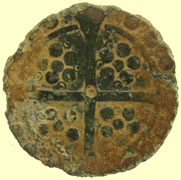 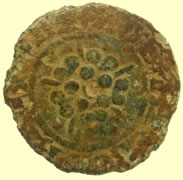 |
|||||||||||||||||||||||||||||||||
Stunning English medieval jetton not in ref books Appears to be the same period and design circa 1280 like the Lions of England type but this has a winged bird of prey on Obv |
Rare English jetton, 1345/55 Late pictorial issues of the mid century : This type with the obverse as a rose is not in Mitchiner but could be a mule with Mitchiner 186 Obv Barbed rose 5 petals, border fictitious legend Rev Long cross patonace , 6 pellet clusters in each angle, border pellets Ref Mitchiner 245 |
|||||||||||||||||||||||||||||||||
  |
  |
|||||||||||||||||||||||||||||||||
Unknown type with *I* I on Obv instead of pellets 1321 Edward II English jetton - Bust type Class XI Obv Edward bust with succession of * and I Rev Three armed cross, in each angle a 'facing bare human head ' border,, succession of letters B and S Similar Ref Mitchiner 131 but with different legend |
1296-97 Edward 1st Jetton Class 11 to 15 Obv Hexagon containing rose (5 petals) border, pellets Rev Short cross Moline , pellet in each angle:border pellets Ref Mitchiner 230 |
|||||||||||||||||||||||||||||||||
  |
  |
|||||||||||||||||||||||||||||||||
| c1344-51 Edward III Jetton, based on gold florin coinage- 'Wardrobe counters' | 1321-43 Sterling bust English Jetton Edward II Class XV Rev - Long cross patonce Obv - Bust Class 15 in circle, border pellets |
|||||||||||||||||||||||||||||||||
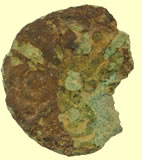 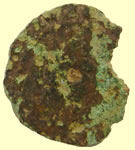 |
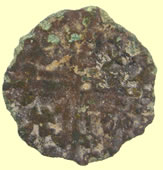 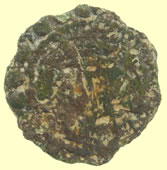 |
|||||||||||||||||||||||||||||||||
1302- 50 AD Sterling bust English medieval jetton Obv Bust , wearing cap ,in circle:border, strokes and pellets Rev Straight cross 'quatrefoil-in-circles' in angles, border pellets |
13thC English jetton Obv - Edward bust Rev - Long cross and pellets |
|||||||||||||||||||||||||||||||||
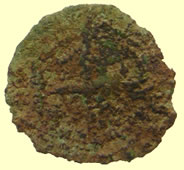 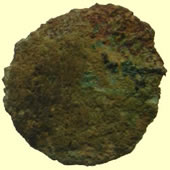 |
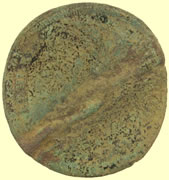  |
|||||||||||||||||||||||||||||||||
English medieval Edward jetton |
1689- 94 William and Mary type jetton Kings' diademed bust right Obv WILLH.IIID.G.ANG.SCO.FR.ET.HI.REX Rev Queens head diademed bust right Ref Mitchiner 1804 |
|||||||||||||||||||||||||||||||||
English Medieval Jeton with pictorial obverses: Obv Shield bearing lion rampant right 2 pellets on left, 2 annulets right:border, strokes and annulets Rev Triple stranded cross fleury,with star and crescent in each angle:3 -pellet cluster in each segment This Jeton is fitted with a clasp, enabling it to be used as a brooch displaying the 'star and crescent' emblems Ref Mitchener 169a Appendix two
|
||||||||||||||||||||||||||||||||||
Circa 1710. Queen Anne. Rev. FVNDAMENTVM QVIETIS NOSTRAE. ECCLES. ANGL. Brass 26mm. by Lazarus G. Lauffer Nuremburg. FVNDAMENTVM QVIETIS NOSTRAE. ECCLES. ANGL means The Church of England is the basis (or foundation) of our Peace. These were early propaganda tokens/jetons stressing that the protestant church was the way to maintain peace in Great Britain. Both Queen Anne & King George faced threats from legitimate claimants to the throne. These were Catholic and supported by french funds and sometimes french troops and had tremendous support in Scotland and Ireland plus some support from catholic families even in England. |
||||||||||||||||||||||||||||||||||
German Jettons
|
||||||||||||||||||||||||||||||||||
Germany: Although it might seem that Nuremberg was the only German city to strike jettons, this is far from the case. Although they are not commonly seen in Britain, jettons may be found from Prussia, Saxony, Bohemia etc. and there is an extensive series from Hanover. These were issued by the mint-masters in Clausthal and Zellerfeld, and those struck during the 18th century have the same names or initials as appear on the Anglo- Hanoverian coins.
|
||||||||||||||||||||||||||||||||||
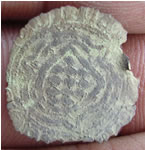 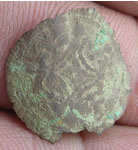 |
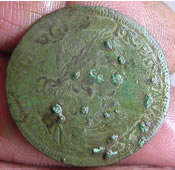  |
|||||||||||||||||||||||||||||||||
Period of Frederick III 1440- 1493 Nuremberg -Mainz -Bavaria type Lozengy shield of Bavaria |
GERMANY,
28mm brass jeton, laureate bust R, LVDOVIC XIII D G FR ET NAVAR REX
/ crowned arms of France & Navarre, CONRADT LAVFER RECHEPFENNM,
by Conrad Lauffer in Nuremberg, 1637-68 |
|||||||||||||||||||||||||||||||||
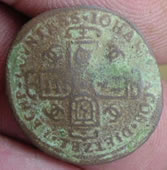 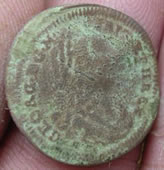 |
 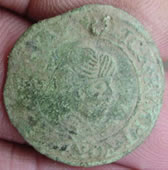 |
|||||||||||||||||||||||||||||||||
Johan Jacob Dietzel of Nürnberg who made this sometime between 1711 and 1748.
Obverse "GEORG.DG.M.(.........) Reverse: "IOHAN(N.I)ACOB.DIETZEL.RECHP.COUNTERS" |
1608 AD Hans Schultes III 'Turbanded bust' German Jetton. Male bust right wearing a turban. 1.28g, 22.23mm obv GLICK 4 foil KVMPT 4 foil VON flower GOT 4 foil ISTWAR rev Traditional imperial orb with cross patty in a tressure with 3 main arches, 3 pairs of pellets inside the tressure rosette HANS:SCHVLTES:ZV:NVRNB |
|||||||||||||||||||||||||||||||||
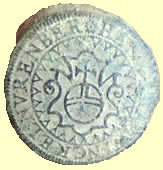  |
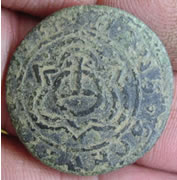 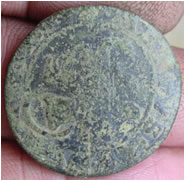 |
|||||||||||||||||||||||||||||||||
1562 AD Hans Krauwinckel I Master German Lion of St Mark Jetton, 19.27g, 30.02mm Lion of St Mark standing left with both wings shown. Book of the Gospels between fore- paws.Halo, rising into the margin, is surrounded by a star: Obv *S*MARCVS * EVANGELLIST*GOTT*** Rev Imperial Orb surrounded by cross patty witin an ornate tressure *HANNS * KRVRENBER The normal weight for this type is 7.95g to 11.30 g, this specimin weights 19.27g ???? It is acually two of the same type of Jettons stuck together
|
1553- 86 AD Hans Schultes I ‘Lion of St Mark’ Jetton obv Lion of St mark standing left, nimbate and winged, holding book of the Gospels in right fore paw: Lions halo orjecting into the margin and surmounted by a cross + SANT:MARGVS:NORPED Rev Imperial orb surmouned by cross patty HANS rosette SCHVTLTES rosette NORNBE Ref Mitchiner 1382 |
|||||||||||||||||||||||||||||||||
 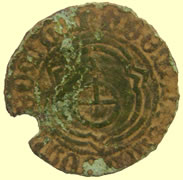 |
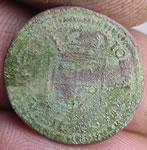 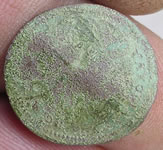 |
|||||||||||||||||||||||||||||||||
| 1525 'Ship -orb' Jetton - fictitious inscription | Johan Jacob Dietzel of Nürnberg who made this sometime between 1711 and 1748. |
|||||||||||||||||||||||||||||||||
  |
  |
|||||||||||||||||||||||||||||||||
1553- 86 AD Hans Schultes I ‘Lion of St Mark’ Jetton obv Lion of St mark standing left, nimbate and winged, holding book of the Gospels in right fore paw: Lions halo orjecting into the margin and surmounted by a cross + SANT:MARGVS:NORPED Rev Imperial orb surmouned by cross patty HANS rosette SCHVTLTES rosette NORNBE Ref Mitchiner 1382 |
1553 Hans Schultes I 'Ship penny' jetton Obv Sailing ship facing left Rev Traditional 'four fleurs in a lozenge' crown HANS rosette SCHVLTES cross PO
|
|||||||||||||||||||||||||||||||||
  |
  |
|||||||||||||||||||||||||||||||||
1608 AD Hans Schultes III 'Turbanded bust' German Jetton. Male bust right wearing a turban. 1.28g, 22.23mm obv GLICK 4 foil KVMPT 4 foil VON flower GOT 4 foil ISTWAR rev Traditional imperial orb with cross patty in a tressure with 3 main arches, 3 pairs of pellets inside the tressure rosette HANS:SCHVLTES:ZV:NVRNB |
1570 Egidius Krauwinckle Rose orb jetton |
|||||||||||||||||||||||||||||||||
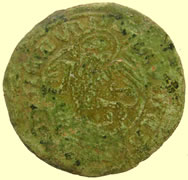  |
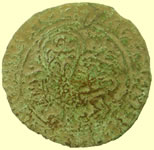 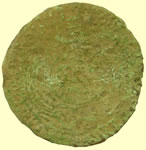 |
|||||||||||||||||||||||||||||||||
1515 -59 Iorg Schultes Master, German Lion of St Mark Jetton, Lions halo projects above inner circle and interrupt legend Lion of St Mark standing left with both wings shown. Book of the Gospels between fore- paws.Halo, rising into the margin, is surrounded by a star: Rev Large Orb no initial mark, 3 pairs of annulets outside tressure Ref Mitchiner 1113 |
1562 AD Hans Krauwinckel I Master German Lion of St Mark Jetton, 19.27g, 30.02mm Lion of St Mark standing left with both wings shown. Book of the Gospels between fore- paws.Halo, rising into the margin, is surrounded by a star: Obv *S*MARCVS * EVANGELLIST*GOTT*** Rev Imperial Orb surrounded by cross patty witin an ornate tressure *HANNS * KRVRENBER |
|||||||||||||||||||||||||||||||||
  |
||||||||||||||||||||||||||||||||||
Excellent find Damianus Krauwinckel Master 1543 - first active member of the Krauwinckel family 'Lion of Saint Mark' jetton Lion of St Mark standing left ,nimbate and winged, holding book of the Gospels Obv DOMIANVS rosette KRAVWINCK Rev Imperial orb surrounded by cross patty - fictitious inscription |
||||||||||||||||||||||||||||||||||
  |
  |
|||||||||||||||||||||||||||||||||
| 1608 AD Hans Schultes III, looks like 'Turbanded bust' German Jetton. | 1553- 86 AD Hans Schultes I ‘Lion of St Mark’ Jetton obv Lion of St mark standing left, nimbate and winged, holding book of the Gospels in right fore paw: Lions halo orjecting into the margin and surmounted by a cross + SANT:MARGVS:NORPED Rev Imperial orb surmouned by cross patty HANS rosette SCHVTLTES rosette NORNBE Ref Mitchiner 1382 |
|||||||||||||||||||||||||||||||||
  |
  |
|||||||||||||||||||||||||||||||||
1562 AD Hans Krauwinckel I Master German Lion of St Mark Jetton Lion of St Mark standing left with both wings shown. Book of the Gospels between fore- paws.Halo, rising into the margin, is surrounded by a star: Obv *S*MARCVS * EVANGELLIST*GOTT*** Rev Imperial Orb surrounded by cross patty witin an ornate tressure *HANNS * KRVRENBER |
c1490-1500 the 'ship-penny'jettons Obv Profile of a sailing ship VOLGVE LA GALI DE OD BLA Rev Four fleur de lis in a lozenge Ref Mitchiner 1142 |
|||||||||||||||||||||||||||||||||
  |
  |
|||||||||||||||||||||||||||||||||
Very unusual Jetton as this purports to be a 16thC Mercury bust Jetton of one of the Kravwinckel or Lauffer families, howvever it only has a series of flowers as a legend both sides ?? Not listed in Mitchener |
1553 Hans Schultes I 'Ship penny' jetton Obv Sailing ship facing left Rev Traditional 'four fleurs in a lozenge' crown HANS rosette SCHVLTES cross PO |
|||||||||||||||||||||||||||||||||
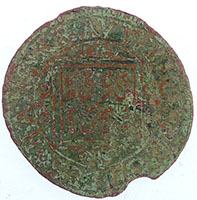 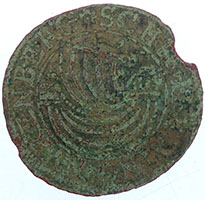 |
  |
|||||||||||||||||||||||||||||||||
1490- 1550 'Ship -penny' Jetton Obv Sailing ship facing left Rev Traditional 'four fleurs in a lozenge' crown HANS rosette SCHVLTES cross PO |
1490-1550 Low countries 'Venus penny' jetton | |||||||||||||||||||||||||||||||||
 |
  |
|||||||||||||||||||||||||||||||||
'Mercury Type' Hans Schvltes III 1608-1612 Nuremberg jetton. Obv GLIK.KVMPT.VON.GOT.ISTWA |
Wolf Lauffer II 1612-1651 German Jetton master This Jetton is dated to 1640 |
|||||||||||||||||||||||||||||||||
  |
  |
|||||||||||||||||||||||||||||||||
Wolf Lauffer II 1612-1651 German Jetton master This Jetton is dated to 1640 Diademed bust of Louis XIV right - LVS.XIIII.D.G:FR.ET.NAV:REX Rev Crowned French shield (bearing 3 Lis)WOLF LAVFER RECHPF: MACH IN N:B |
1553 Hans Schultes I 'Ship penny' jetton Obv Sailing ship facing left Rev Traditional 'four fleurs in a lozenge' crown HANS rosette SCHVLTES cross PO |
|||||||||||||||||||||||||||||||||
  |
  |
|||||||||||||||||||||||||||||||||
| 1562 AD Hans Krauwinckel I Master German Lion of St Mark Jetton | 1601 Wolf Laffer Rose Orb jetton Obv Three crowns and 3 Lis centrifugally around central rose Rev Imperial orb |
|||||||||||||||||||||||||||||||||
  |
  |
|||||||||||||||||||||||||||||||||
| 1553- 86 AD Hans Schultes I ‘Lion of St Mark’ Jetton | 1562 AD Hans Krauwinckel I Master German Lion of St Mark Jetton | |||||||||||||||||||||||||||||||||
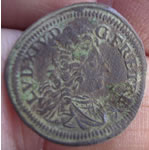 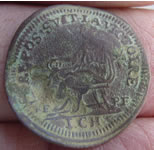 |
  |
|||||||||||||||||||||||||||||||||
Johan Conrad Hergen, master 1705 French style jetton 1705 -1743 Kings diademed bust right LVD.XV.D.G.FR.N.RE Tranquillity seated left, Crown on right knee in exergue I.C.H LE.REPROS.SUIT.LA.VICTOIRE |
1553 Hans Schultes I 'Ship penny' jetton Obv Sailing ship facing left Rev Traditional 'four fleurs in a lozenge' crown HANS rosette SCHVLTES cross PO |
|||||||||||||||||||||||||||||||||
  |
  |
|||||||||||||||||||||||||||||||||
| Unknown Rose Orb Jetton - not in Mitchener Ref book | 1553- 86 AD Hans Schultes I ‘Lion of St Mark’ Jetton obv Lion of St mark standing left, nimbate and winged, holding book of the Gospels in right fore paw: Lions halo orjecting into the margin and surmounted by a cross + SANT:MARGVS:NORPED Rev Imperial orb surmouned by cross patty HANS rosette SCHVTLTES rosette NORNBE Ref Mitchiner 1382 |
|||||||||||||||||||||||||||||||||
1490- 1550 'Ship -penny' Jetton anonymous issues |
||||||||||||||||||||||||||||||||||
French JettonsFrance: the earliest French jettons are claimed to be from the reign of Louis VIII (1218-1252) ; but this is based on royal coats of arms shown on some early pieces. There is a great variety of types, all copper or brass until mid/late 15th century when silver was also used. Silver jettons are very rare at first, but very common by the end of the 17th century; by which time their original function had virtually ceased. Almost all were struck at the Paris mint; their right to strike jettons being very jealously guarded. Very similar pieces were still being struck late into the 19th century. Certain jettons made in France are contemporary with those made in England in the second half of the 14th century, and only a very few date earlier. It is important to note that certain designs – such as the Standing King and Seated King – are seen on both French and English issues as they share the same coin designs as prototypes. The French jettons can be distinguished from English ones in two ways: the flan will not have a central punch and many feature a legend. A main feature to look for on French jettons is an elaborate, but generally neat, reverse cross. These crosses are generally have multiple strands and their arms terminate in lis. The most common is a triple-stranded straight cross within a double quadrilobe border; less common is a double-stranded arcuate cross (i.e. with incurved sides), with other minor varieties also encountered. Note that many of the earlier types within the French series are of smaller size and bear an arcuate cross on their reverse. The classification of French jettons is based on their obverse designs; designs from this early period include the ‘Moor’s head’ type, and small module examples of the ‘Crown’ and ‘Chatel Tournois’ types. The main series is dominated by obverse designs such as a larger module ‘Crown’ type and the ‘France Modern’ type, depicting a shield with three lis; the ‘France Ancient’ type has more than three lis. The predominant legend is the Hail Mary, ‘AVE MARIA GRACIA PLENA’, often with the final word abbreviated. Late Tournai jettonsAs noted in the previous section, Tournai (in modern-day Belgium) was an official French mint. It came to dominate production from the 15th century until the very early 16th century, especially from after c. 1450, and so it is useful to isolate as a separate category following on from the more general French production in this period. The obverse types ascribable to Tournai in this period fall into two main groups. The first is a group of derivative French designs. They are struck more crudely than earlier jettons, and on larger, thicker flans. In particular, look for Crown types and shields of France Modern, the latter with slightly bulging sides to the shields at their tops (Mernick and Algar in Saunders ed. 2001). Other characteristic traits of this group include saltire cross initial marks and the presence of letters on the reverse cusps, rather than florets. The second group consists of relatively neat jettons with a reverse design of a cross potent with flowers in each angle. They often have a legend based on ‘SIT NOMEN DOMINI’ (from ‘Sit nomen Domini benedictum’ – ‘Blessed be the name of the Lord’), with the Ns often unbarred. Obverse types include angular shields, three circles (of Tournai) and monograms (Mernick and Algar in Saunders ed. 2001, 257; fig. 85). This group tends to be dated c. 1475-1525.
|
||||||||||||||||||||||||||||||||||
Mint condition 1340 AD French Jetton Crown introduced in 1340 by Philip VI (1328-50) Royal Crown with 3 rosettes across body of crown Rev Triple banded straight cross fleuretty AV
|
||||||||||||||||||||||||||||||||||
As new Jetton found in pond silt. Never seen a medeival coin in this brand new shape. Crown introduced in 1340 by Philip VI (1328-50) Royal Crown with 2 annulet and rosette across body of crown Rev Triple banded straight cross fleuretty AV Obv *AVE MARIA* GRACIA*PIH |
||||||||||||||||||||||||||||||||||
 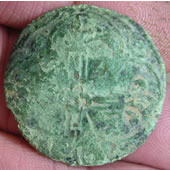 |
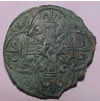 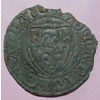 |
|||||||||||||||||||||||||||||||||
|
??
|
Charles
VI Medieval Jetton 1380 to 1422 AD |
|||||||||||||||||||||||||||||||||
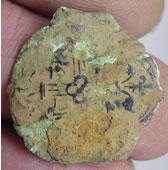 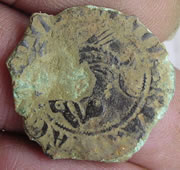 |
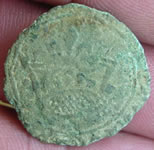 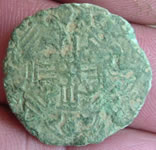 |
|||||||||||||||||||||||||||||||||
Mid
14thC Dolphin type bronze Jetton - south eastern France |
Circa
1437 French Crown with ornaments type jetton - Paris Mint |
|||||||||||||||||||||||||||||||||
  |
  |
|||||||||||||||||||||||||||||||||
14thC French Stock jeton struck for the Queen and her almonry First used by Queen Marguerite de Provence, wife of Louis IX Moor's head right with hair bound Obv +AVE MARIA GRACIA PLENA Rev Lis at centre of reverse cross type |
13thC French jetton Obv 3 fleurs de lis DETOUR+DETOUR Rev Double stranded arcuate cross feuilly with pellet at centre PAI - DIEV -NOV NOIN |
|||||||||||||||||||||||||||||||||
  |
  |
|||||||||||||||||||||||||||||||||
The Standing King series Charles IV 1322-28 French Jetton Obv 'king with sceptre standing beneath a gothic canopy' |
Louis XII (1497-1515)French Jetton Rev Simple cross patty Obv Three circles of Tournai |
|||||||||||||||||||||||||||||||||
  |
  |
|||||||||||||||||||||||||||||||||
Stock Jetton for the Queen and her almony 14th to15th C Emblem of Queen marguerite de Provence, wife of Louis IX Moor's head right with hair bound Obv X AVE MARIA GRACIA PLNA |
1418- 1437 Charles VII Paschal lamb type jetton, Bourges Paschal lamb standing with one foot raised head nimbate Obv+ GETES star DIEV star FALIR Simple single armed cross patty with lis bewtween each arm Rev + AMIES star DIEV star ET star LO Ref Mitchiner 558 |
|||||||||||||||||||||||||||||||||
  |
  |
|||||||||||||||||||||||||||||||||
1371 Feudal French Jetton – Loraine and Bar type |
The Standing King series Charles IV 1322-28 French Jetton Obv 'king with sceptre standing beneath a gothic canopy' |
|||||||||||||||||||||||||||||||||
  |
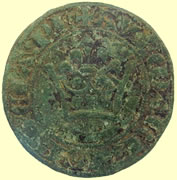 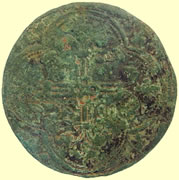 |
|||||||||||||||||||||||||||||||||
Crown introduced in 1340 by Philip VI (1328-50) Royal Crown with 3 rosettes across body of crown Rev Triple banded straight cross fleuretty AV |
Mint condition 1340 AD French Jetton Crown introduced in 1340 by Philip VI (1328-50) Royal Crown with 3 rosettes across body of crown Rev Triple banded straight cross fleuretty AV |
|||||||||||||||||||||||||||||||||
  |
  |
|||||||||||||||||||||||||||||||||
Stock Jetton for the Queen and her almony 14th to15th C Emblem of Queen marguerite de Provence, wife of Louis IX Moor's head right with hair bound Obv X AVE MARIA GRACIA PLNA |
The Standing King series Charles IV 1322-28 French Jetton Obv 'king with sceptre standing beneath a gothic canopy' |
|||||||||||||||||||||||||||||||||
  |
  |
|||||||||||||||||||||||||||||||||
15thC French Chatel Tournois Jetton Obv Traditional Chatel Tournois (Castle of Tours) SIB IIOIIIEIII BOIII II I Ref Mitchener 741 |
1285 - 1314 AD West Central France jeton The Paschal lamb jeton - ' I am the lamb of Berry' Obv MOVTON SVI:DE BE - Pascall lamb standing left, with one foot raised Rev Triple stranded cross fleuretty within 4 arched tressure |
|||||||||||||||||||||||||||||||||
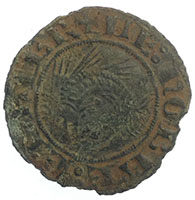 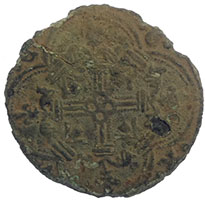 |
 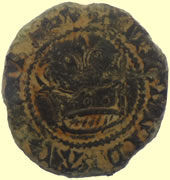 |
|||||||||||||||||||||||||||||||||
Mid 14thC c1449 Dolphin type bronze Jetton - south eastern France Bowed Dolphin left, holding a purse in mouth +LE:NOBLE:ET.FIER:POI Rev Triple standed straight cross fleuretty within 4 arched tressure arpind C-A-V-E |
1340 AD French Jetton Crown introduced in 1340 by Philip VI (1328-50) Royal Crown annulets across body of crown Obv AVE MARIA GRACIA Rev A-V-E-M Rev Triple banded straight cross fleuretty Ref Mitchiner 663 (close to) |
|||||||||||||||||||||||||||||||||
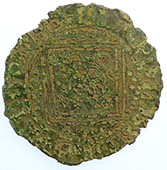 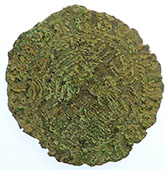 |
  |
|||||||||||||||||||||||||||||||||
| French 1490- 1550 'Ship -penny' Jetton anonymous issue | 1340 AD French Jetton Crown introduced in 1340 by Philip VI (1328-50) Royal Crown with 3 rosettes across body of crown Rev Triple banded straight cross fleuretty AV |
|||||||||||||||||||||||||||||||||
  |
  |
|||||||||||||||||||||||||||||||||
1340 AD French Jetton Crown introduced in 1340 by Philip VI (1328-50) Royal Crown with 3 rosettes across body of crown |
1340 AD French Jetton Crown introduced in 1340 by Philip VI (1328-50) Royal Crown Rev Triple banded straight cross fleuretty AV |
|||||||||||||||||||||||||||||||||
  |
|
|||||||||||||||||||||||||||||||||
| Charles VI Medieval Jetton 1380 to 1422 AD | 1418-1437 Charles VII of Bourges, Paschal Lamp type jetton | |||||||||||||||||||||||||||||||||
  |
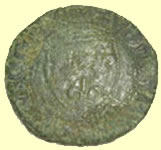 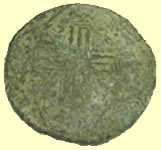 |
|||||||||||||||||||||||||||||||||
Louis XII 1497-1515 French jetton |
Charles
VI Medieval Jetton 1380 to 1422 AD |
|||||||||||||||||||||||||||||||||
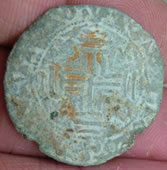 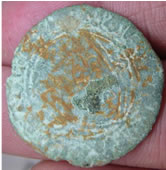 |
|
|||||||||||||||||||||||||||||||||
1478 Louis XI Shield of France Jetton – Cross fleuretty with roses on reverse Ref Mitchiner 706 |
Mint condition 1340 AD French Jetton Crown introduced in 1340 by Philip VI (1328-50) Royal Crown with 3 rosettes across body of crown Rev Triple banded straight cross fleuretty AV |
|||||||||||||||||||||||||||||||||
  |
 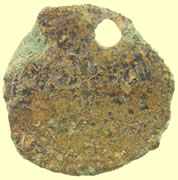 |
|||||||||||||||||||||||||||||||||
15thC French stock Jetton of Sedan - The use of 'cross feuilly' suggests a Northern mint. Ref Mitchener 712 |
The 'Field of France' French Jetton, a field bearing numerous fleurs de lis stuck by John the Good 1350- 64 AD 9 fleurs de lis type |
|||||||||||||||||||||||||||||||||
  |
  |
|||||||||||||||||||||||||||||||||
Crown introduced in 1340 by Philip VI (1328-50) Royal Crown with 3 rosettes across body of crown Rev Triple banded straight cross fleuretty AV |
French Jetton Crown introduced in 1340 by Philip VI (1328-50) Royal Crown with 3 rosettes across body of crown Rev Triple banded straight cross fleuretty AV |
|||||||||||||||||||||||||||||||||
  |
  |
|||||||||||||||||||||||||||||||||
1340 AD French Jetton Crown introduced in 1340 by Philip VI (1328-50) Royal Crown with 3 rosettes across body of crown Rev Triple banded straight cross fleuretty AV |
1497 - 1515 Louis XII French jetton - simple cross patty |
|||||||||||||||||||||||||||||||||
  |
  |
|||||||||||||||||||||||||||||||||
The Standing King series Charles IV 1322-28 French Jetton Obv 'king with sceptre standing beneath a gothic canopy' Type 404 Mitchiner Rev Triple stranded straight cross fleuretty in 4 arched tressure |
1497-1515 Louis XII Tower shield of Tournai French Jetton | |||||||||||||||||||||||||||||||||
  |
  |
|||||||||||||||||||||||||||||||||
1461 Paris type Jetton - 'lozenge containing four lis' VIVE:LE:BON:ROI:DE:FRANCE |
1340 AD French Jetton Crown introduced in 1340 by Philip VI (1328-50) Royal Crown with 3 rosettes across body of crown Rev Triple banded straight cross fleuretty AV |
|||||||||||||||||||||||||||||||||
  |
  |
|||||||||||||||||||||||||||||||||
1346-80 Charles V Shield of France ancient type jetton Obv + AVE MARIA GRACIA PLE Rev Double stranded arcuate cross fleuretty with lis at centre
|
circa 1447 Charles VII Jetton with IHS Letters IHS in gothic script acorss field with upright stroke of H crossed AVE IIIARI STEELA DEI IIIATER Rev Double stranded arcuate cross fleuretty with pellet at centre |
|||||||||||||||||||||||||||||||||
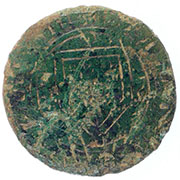 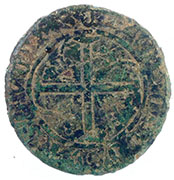 |
  |
|||||||||||||||||||||||||||||||||
French 1497-1515 Tower shield of Tournai jetton Ref 724 Mitchener |
1373-to 1414 struck by Charles V to VI Paschal lamb jetton of Bourge (Berry) Obv +MOTION SVI: DE BERRI Paschal lamb standing left with one foot raised:head nimbate and reverted to view flag with cross at top Mitch Ref 498 |
|||||||||||||||||||||||||||||||||
 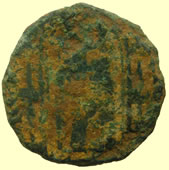 |
  |
|||||||||||||||||||||||||||||||||
1371-1379 Duchy of Guelders - Mathide de Gueldre Rev Double standard arcuate cross fleuretty with a rampant lion (single tail) in each qtr |
Interesting unrecorded 1422 shield of France type Jetton not in Mitchener 3 Lis in a shield with what appears to be snakes above and to sides of shield Obv + AVE MARIA + GRACIA |
|||||||||||||||||||||||||||||||||
  |
  |
|||||||||||||||||||||||||||||||||
1340 AD French Jetton Crown introduced in 1340 by Philip VI (1328-50) Royal Crown with annulet and rosettes across body of crown Obv AVE MARIA GRACIA Rev A-V-E-M Rev Triple banded straight cross fleuretty Ref Mitchiner 469 |
The Standing King series Charles IV 1322-28 French Jetton Obv 'king with sceptre standing beneath a gothic canopy' |
|||||||||||||||||||||||||||||||||
  |
  |
|||||||||||||||||||||||||||||||||
1340 AD French Jetton Crown introduced in 1340 by Philip VI (1328-50) Royal Crown with 3 rosettes across body of crown |
15thC French jetton - leafty ornaments around a central cross |
|||||||||||||||||||||||||||||||||
|
  |
|||||||||||||||||||||||||||||||||
| French jetton | 15thC French - Four fleurs de lis in a lozenge jetton |
|||||||||||||||||||||||||||||||||
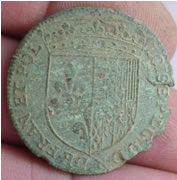 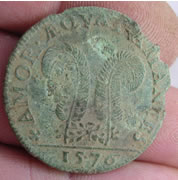 |
  |
|||||||||||||||||||||||||||||||||
1576 Henry 111 (1574-1589) obv +AMOR A Q YA rev DE FRAN ET POL LOIS SPLG DD |
1371-1379 Duchy of Guelders jetton Rampant Lion with a tall erect two forked tail was first introduced as the emblem of Limburg Rev Rampant Lion with a tall erect two forked tail of Limburg- all in 6 arched tressure -margin M repeated Rev Double stranded arcuate cross fleuretty with rampant lion (single tail) in each angle:margins crowns |
|||||||||||||||||||||||||||||||||
  |
  |
|||||||||||||||||||||||||||||||||
13thC French jetton |
Medieval French jetton | |||||||||||||||||||||||||||||||||
  |
  |
|||||||||||||||||||||||||||||||||
| Medieval French jetton | Medieval French copper jetton | |||||||||||||||||||||||||||||||||
  |
  |
|||||||||||||||||||||||||||||||||
| Medieval French jetton | 1340 AD French Jetton Crown introduced in 1340 by Philip VI (1328-50) Royal Crown with 3 rosettes across body of crown Rev Double banded straight cross fleuretty AV |
|||||||||||||||||||||||||||||||||
 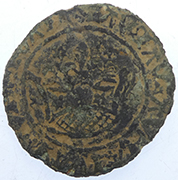 |
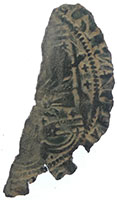  |
|||||||||||||||||||||||||||||||||
1340 AD French Jetton Crown introduced in 1340 by Philip VI (1328-50) Royal Crown with 3 rosettes across body of crown Rev Triple banded straight cross fleuretty AV |
The Standing King series Charles IV 1322-28 French Jetton Obv 'king with sceptre standing beneath a gothic canopy' |
|||||||||||||||||||||||||||||||||
 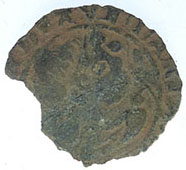 |
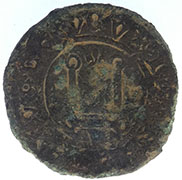  |
|||||||||||||||||||||||||||||||||
| Medieval French jetton | 15thC French Chatel Tournois jetton | |||||||||||||||||||||||||||||||||
  |
  |
|||||||||||||||||||||||||||||||||
1340 AD French Jetton Crown introduced in 1340 by Philip VI (1328-50) Royal Crown with 3 rosettes across body of crown Rev Triple banded straight cross fleuretty AV |
1430's French Charles VII Three circles type jetton - mint of Tournai Quatrefoils in circle Ref Mitchiner 607 |
|||||||||||||||||||||||||||||||||
French 'shield of France' type - 3 Lis in a shield and '4 Lis in a quadrant' |
||||||||||||||||||||||||||||||||||
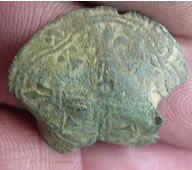 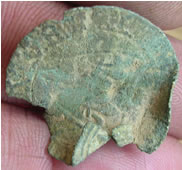 |
  |
|||||||||||||||||||||||||||||||||
  |
 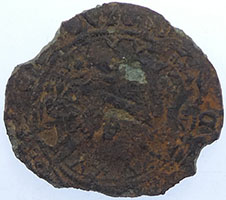 |
|||||||||||||||||||||||||||||||||
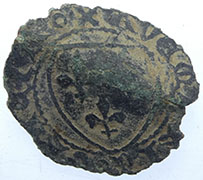 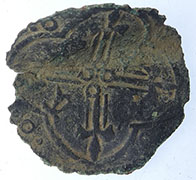 |
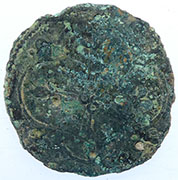 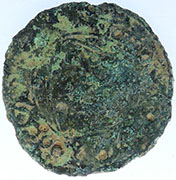 |
|||||||||||||||||||||||||||||||||
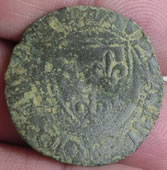 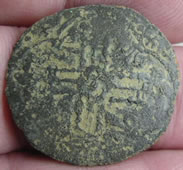 |
 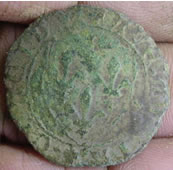 |
|||||||||||||||||||||||||||||||||
  |
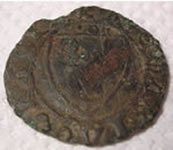 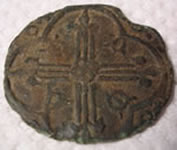 |
|||||||||||||||||||||||||||||||||
  |
  |
|||||||||||||||||||||||||||||||||
  |
  |
|||||||||||||||||||||||||||||||||
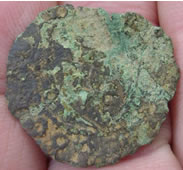 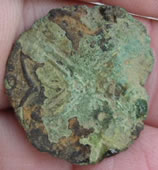 |
  |
|||||||||||||||||||||||||||||||||
  |
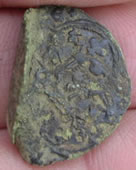 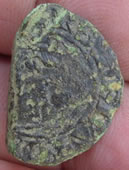 |
|||||||||||||||||||||||||||||||||
  |
  |
|||||||||||||||||||||||||||||||||
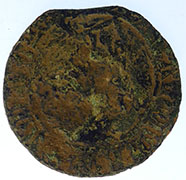 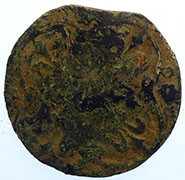 |
  |
|||||||||||||||||||||||||||||||||
  |
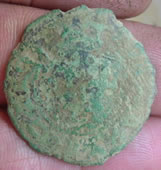 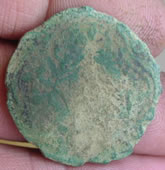 |
|||||||||||||||||||||||||||||||||
  |
  |
|||||||||||||||||||||||||||||||||
  |
  |
|||||||||||||||||||||||||||||||||
  |
  |
|||||||||||||||||||||||||||||||||
  |
  |
|||||||||||||||||||||||||||||||||
  |
  |
|||||||||||||||||||||||||||||||||
  |
  |
|||||||||||||||||||||||||||||||||
 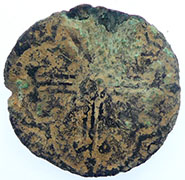 |
 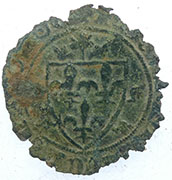 |
|||||||||||||||||||||||||||||||||
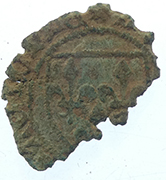 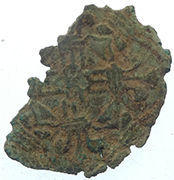 |
  |
|||||||||||||||||||||||||||||||||
German Rose Orb Jettons
Mint mudlark find Four different Krauwinckel makers made “rose and orb” type jettons, including brothers Damianus and Hans (I) Krauwinckel, and Egidius and Hanns (II) Krauwinckel who were the sons of Damianus. Hans Krauwinckel (1562-1586) Hans Krauwinckel II (1586-1635) Hans Lauffer (1611-1632) Hans Schultes The reverse side of the “rose and orb” jettons depicts an imperial orb within a trilobe. The surrounding letters are often various verses from the Bible. Inscribed GOTES SEGEN MACHT REICH (“God’s blessing brings riches”). GETRIVW HANDT KOMBT DURCH ALLE (“Truth succeeds over all”) GLUCK BESCHERT IST VNGEWERT (“Fortune given is not guaranteed”) GOTES REICH BLIBT EWICK (“God’s Kingdom remains eternal”) GOTT ALLEIN DIE EERE SEI (“To God alone the glory”) HEIT ROTT MORGEN DOTT (“Red today, dead tomorrow”) VERBVM DOMINI MANET IN ETERN (“The Word of God remains eternal”)
Mint condition pond silt find - 1500-1550 'Normal orb' German jetton with crown initial mark Annonymous issue Pond silt find
Smallest Jetton I have ever seen, it is like a 1586 Hans Krauwincel II Rose orb Jetton - not in ref books 0.54g, 14.22mm |
||||||||||||||||||||||||||||||||||
|
|
||||||||||||||||||||||||||||||||||
Spanish Jetton
|
||||||||||||||||||||||||||||||||||
  |
||||||||||||||||||||||||||||||||||
1549 Philip, prince of Spain Jetton , Crowned quarterly shield of Spain + low countries 2.37g, 24.67mm |
||||||||||||||||||||||||||||||||||
Unknowns
|
||||||||||||||||||||||||||||||||||
  |
  |
|||||||||||||||||||||||||||||||||
Interesting 16thC Jetton |
17thC Continental jetton |
|||||||||||||||||||||||||||||||||
  |
  |
|||||||||||||||||||||||||||||||||
Interesting 16thC jetton |
Unknown |
|||||||||||||||||||||||||||||||||
  |
  |
|||||||||||||||||||||||||||||||||
15thC Continental jetton - Working on ID Obv PBS DG HIB REX CO ZEA Rev PACE |
17thC Continental Jetton | |||||||||||||||||||||||||||||||||
  |
  |
|||||||||||||||||||||||||||||||||
| French copper-alloy Jetton 1380AD | 1586 Hans Krauwincel II Rose orb Jeton | |||||||||||||||||||||||||||||||||
  |
  |
|||||||||||||||||||||||||||||||||
| 16thC Continental jetton - not checked ref books yet | Unknown Jetton looking coin | |||||||||||||||||||||||||||||||||
  |
 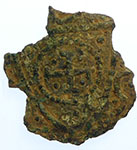 |
|||||||||||||||||||||||||||||||||
| Interesting Continental 17th/18thC looking jetton | Unknown Jetton ? 14thC Cross moline type ? |
|||||||||||||||||||||||||||||||||

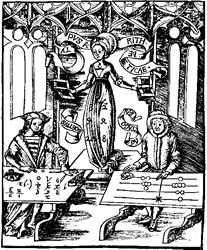 In
English a reckoning counter. Also Jeton (French) & Rechen-pfenning
(German). A coin-like object used in the calculation of accounts. Most
commonly made of copper or brass; but also silver (especially 17th century
and after: very rarely gold. Lead jettons are also known but their purpose
is obscure as they would wear out fast. Jettons are known from England,
France, Netherlands, Germany, Austria, Poland, Czechoslovakia, Hungary,
Italy, Portugal, Spain & probably other countries. Originally "jettons"
would have been pebbles or pieces of pottery (the word calculate derives
from Calx - pebble). The first specially struck jettons seem to be mid
13th century (French), the earliest English third quarter 13th century.
In
English a reckoning counter. Also Jeton (French) & Rechen-pfenning
(German). A coin-like object used in the calculation of accounts. Most
commonly made of copper or brass; but also silver (especially 17th century
and after: very rarely gold. Lead jettons are also known but their purpose
is obscure as they would wear out fast. Jettons are known from England,
France, Netherlands, Germany, Austria, Poland, Czechoslovakia, Hungary,
Italy, Portugal, Spain & probably other countries. Originally "jettons"
would have been pebbles or pieces of pottery (the word calculate derives
from Calx - pebble). The first specially struck jettons seem to be mid
13th century (French), the earliest English third quarter 13th century.



